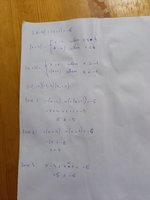You are using an out of date browser. It may not display this or other websites correctly.
You should upgrade or use an alternative browser.
You should upgrade or use an alternative browser.
Absolute value equation
- Thread starter Albi
- Start date
pka
Elite Member
- Joined
- Jan 29, 2005
- Messages
- 11,990
Write it as \(|x-4|+5=|x+1|\) If \(x\ge 4\) we have \((x-4)+5=(x+1)\text{ OR }1=1\) that is correct.[MATH] \left | x-4 \right | - \left | x+1 \right | = -5[/MATH]Guys I solved this equation, and x = 4, but it turns out that the equation works for [MATH]x\geq 4[/MATH] , can someone explain to me how is this possible?
What if \(x<4~?\)
D
Deleted member 4993
Guest
Are you asking "how can you arrive at the conclusion x≥ 1"?[MATH] \left | x-4 \right | - \left | x+1 \right | = -5[/MATH]
Guys I solved this equation, and x = 4, but it turns out that the equation works for [MATH]x\geq 4[/MATH] , can someone explain to me how is this possible?
Dr.Peterson
Elite Member
- Joined
- Nov 12, 2017
- Messages
- 16,850
Please show us how you solved it and got only x = 4. We can't know how you got it wrong without seeing how you got it.[MATH] \left | x-4 \right | - \left | x+1 \right | = -5[/MATH]
Guys I solved this equation, and x = 4, but it turns out that the equation works for [MATH]x\geq 4[/MATH] , can someone explain to me how is this possible?
But pka showed part of the work in a casewise method, namely the part that gives the result you are asking about. Just to take an example, if [MATH]x = 100[/MATH], then [MATH]|x-4|-|x+1| = |96| - |101| = 96 - 101 = -5[/MATH], as required. The same happens for any [MATH]x \ge 4[/MATH].
yesAre you asking "how can you arrive at the conclusion x≥ 1"?
I solved it by casesPlease show us how you solved it and got only x = 4. We can't know how you got it wrong without seeing how you got it.
But pka showed part of the work in a casewise method, namely the part that gives the result you are asking about. Just to take an example, if [MATH]x = 100[/MATH], then [MATH]|x-4|-|x+1| = |96| - |101| = 96 - 101 = -5[/MATH], as required. The same happens for any [MATH]x \ge 4[/MATH].
Attachments
Dr.Peterson
Elite Member
- Joined
- Nov 12, 2017
- Messages
- 16,850
Then what is your question? Your work shows that \(x\ge 4\).I solved it by cases
In the second case, \(-1\le x \lt 4\), you found that \(x=4\), which is not in that case as I interpret it; in the third case, \(x\ge 4\), you found that the equation is always true (since it is equivalent to \(-5=-5\)).
(Incidentally, your list of cases as written seems to omit -1 and 4 themselves; you should make that clearer. And what is that symbol that apparently means infinity?)
pka
Elite Member
- Joined
- Jan 29, 2005
- Messages
- 11,990
Are you asking "how can you arrive at the conclusion x≥ 1"?
But that is incorrect.
If \(x=1\) we have \(|1-4|+5\ne|1+1|\)
I thought he meant 4 instead of 1.But that is incorrect.
If \(x=1\) we have \(|1-4|+5\ne|1+1|\)
I've been used to writing it like that, but I'll try to write it better from now on.Then what is your question? Your work shows that \(x\ge 4\).
In the second case, \(-1\le x \lt 4\), you found that \(x=4\), which is not in that case as I interpret it; in the third case, \(x\ge 4\), you found that the equation is always true (since it is equivalent to \(-5=-5\)).
(Incidentally, your list of cases as written seems to omit -1 and 4 themselves; you should make that clearer. And what is that symbol that apparently means infinity?)
Anyways thank you for the explanation because I was confused with the third case and didn't know whether to include it in my solution or not
Correct.
Case 1:
If x≥4 then
|x-4|-|x+1|
=(x-4)-(x+1)
=-5
So the equation |x+4|-|x+1|=-5 is satisfied by all x≥4
Case 2:
If -1<x<4 then
|x-4|-|x+1|
=-(x-4)-(x+1)
=-2x+3
Now -2x+3=-5 is satisfied by x=4 alone.
So the equation |x+4|-|x+1|=-5 is satisfied by no x: -1<x<4
Case 3:
If x≤-1 then
|x-4|-|x+1|
=-(x-4)+(x+1)
=5
So the equation |x+4|-|x+1|=-5 is satisfied by no x: x≤-1
The only solutions of |x+4|-|x+1|=-5 are values of x: x≥4
Case 1:
If x≥4 then
|x-4|-|x+1|
=(x-4)-(x+1)
=-5
So the equation |x+4|-|x+1|=-5 is satisfied by all x≥4
Case 2:
If -1<x<4 then
|x-4|-|x+1|
=-(x-4)-(x+1)
=-2x+3
Now -2x+3=-5 is satisfied by x=4 alone.
So the equation |x+4|-|x+1|=-5 is satisfied by no x: -1<x<4
Case 3:
If x≤-1 then
|x-4|-|x+1|
=-(x-4)+(x+1)
=5
So the equation |x+4|-|x+1|=-5 is satisfied by no x: x≤-1
The only solutions of |x+4|-|x+1|=-5 are values of x: x≥4
D
Deleted member 4993
Guest
Yes.. I had a "super typo" I was thinking x ≤-4 but wrote the wrong thing....I thought he meant 4 instead of 1.

